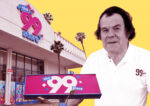Trending
Warren Buffett’s model deal
How a Greenwich Village retail strip became the Oracle of Omaha’s best investment

In a letter to shareholders last month, billionaire investor Warren Buffett cited a Greenwich Village retail strip that he bought in 1993 as one of his best long-term investments.
When the Oracle of Omaha made that cash investment, graffiti dotted the 37 storefronts and handwritten discount signs plastered the merchant windows. The property, along 8th Street between University and Broadway and also wrapping around to 9th Street, was home to an incongruous group of tenants from hot dog joint Annie’s Franks & Fries to Flowers by Arno, along with a couple of darkened storefronts. One of the row’s largest occupants, the now-defunct Woolworth’s, was paying $12 per square foot.
“It was a dreck,” said Adam Rose, whose late father, Fred, invested in the property with Buffett, Larry Silverstein and a small group of other investors. “The previous owner literally plugged space.”
Fast forward, and the 73,700-square-foot property, which has been dubbed “University Walk” and now has 29 stores, boasts national eateries such as Chipotle and Cosi and retail stalwarts Staples and Duane Reade, along with local favorites like the trendy cupcake spot Crumbs and the Knickerbocker Bar & Grill. The property has returned 10 times the initial cash investment of $8.2 million, a performance Buffett touted to shareholders.
Last year, he thanked Silverstein for getting him into the investment, according to a recent email Silverstein wrote and distributed to the media. But it was the Rose family who transformed the property.
“They have done a very good job curating the tenants,” said Ariel Schuster, executive vice president with RKF. “They’ve been selective in the last 15 years in who they put in those spaces, even turning down many tenants.”
Sound and opportunistic
The property’s fortunes didn’t start out rosy. During the Savings and Loan Crisis, the Federal Deposit Insurance Corporation foreclosed on it and, in 1991, handed property management responsibilities to the Brookhill Group.
“When we got it, 30 of the 37 tenants were not paying rents,” said Ron Bruder, founder of the Brookhill Group. “It was in disarray.”
By the time the property went to auction in 1993, all the tenants were paying, the monthly cash receipts had doubled and 57 percent of the tenants renewed, extended or renegotiated their leases, said Bruder.
“We would have bought it ourselves, but it would have been a conflict of interest,” he said. Rose liked the strip, but lacked cash. So before the auction, he courted some friends in high places.
“It was just who was around, and who he was friendly with, and who had the cash,” said the younger Rose.
Among others, the shortlist included Silverstein, the Malkin family, and Buffett, who had befriended Silverstein when he ran Salomon Brothers, which was located in Silverstein’s 7 World Trade.
“We became friendly, and he asked me to put him into a real estate deal that I felt was sound and opportunistic and good enough for me,” Silverstein said in the distributed email. “He invested about $1 million of his money and joined with Fred Rose and me in buying the property.”
Rose went to auction with handshake commitments, but the auction had heavy activity, said Bruder. The Rose-led group came in second, but the winner couldn’t produce the 20-percent deposit within 48 hours. Days later, Rose and company made the highest offer through a sealed bid.
The group put up $8.2 million in cash for the $20.2 million purchase, according to the younger Rose. Fred Rose served as leasing agent and Malkin as managing agent. The others were passive investors.
“It was an unusual collection of investors that we never duplicated,” Adam Rose said. “I think they were all just having fun.”
Tenant turnover
Still, the property desperately need to be redeveloped, said Bruce Spiegel, senior managing director at Rose Associates, who has overseen leasing there since the beginning.
“The storefronts looked like they were leased one-off, not collectively,” Spiegel said.
The transformation didn’t happen overnight; the investors honored existing leases and waited for renewals to come due to make major changes. When Gristede’s lease was up, Rose and Spiegel forced the grocer to renovate if it wanted to stay.
Woolworth’s — which was paying just $12 per square foot for 22,000 square feet of ground floor and basement space — was pushed out once its lease expired. Market rate for the ground floor was between $75 and $100 per square foot, Spiegel said.
Spiegel and the investors didn’t lease to just any tenant. They wanted a mix of local, regional and national names.
“Our best tenant is Mom’s Cooking,” said Spiegel of a local soup and sandwich spot. “They have a line outside for lunch.”
Not all tenants were home runs, Rose said. He recalled several “creative frozen dessert” places along with a Japanese electronics store that didn’t make it.
Another key part of the property’s revival was cleaning up the façade. The group, for example, required new identically shaped awnings, giving retailers the choice of 10 colors.
Not everyone is happy with the metamorphosis. Michael Toback, the owner of 20/20 Eyewear, which has been located at the property for 31 years, said the strip has lost its character and is “frankly ruined.”
“It’s a suburban mini-mall. It’s horrible,” he said. “It used to be great. It was the Village.”
Toback’s lease is up in November, and he’s worried the rent increase will be unaffordable.
“I just want to sign a five-year extension,” he said. “And then I’m out.”
Strong distributions
Still, Buffett said his yearly distributions exceed 35 percent of his original investment. He’s also received special distributions equal to 150 percent of his down payment.
“Fred was an experienced, high-grade real estate investor who, with his family, would manage the property,” Buffett said in his annual shareholder letter. “And manage it they did.”
“I’ve yet to view the property,” he added.
The investors, of course, also got help from outside forces. “It was a different city back then,” said Andrew Mandell, managing partner at Ripco Real Estate. “I’m not sure anyone had the vision 20 years ago that New York City would be where it is today.”
Today, New York University is working on developing two superblocks, set to wrap up in 2021, that will buoy the area’s retail, said James Famularo, senior director at Eastern Consolidated. In addition, the recent office leases to major tech tenants in the area are expected to boost traffic at local stores.
That means University Walk will likely continue to stand the test of time.
“We’ve never gone back to Buffett for another investment, which is not very smart,” Rose said. “I should call him tomorrow and offer him something.”




